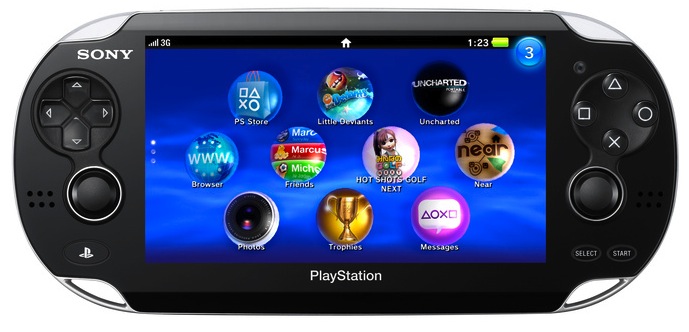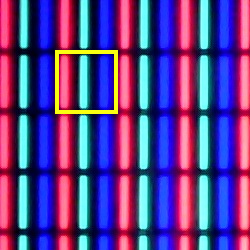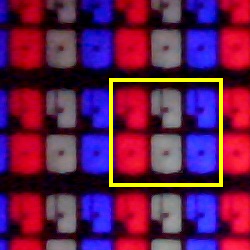
| edepot | World Religion Music Money Games Stores | Forums Feedback Search Sitemap |
| Technology | PS3 Secrets : PSVita Secrets : iPhone Secrets |
Please read: A personal appeal from edepot.com founder |

| The purpose of this webpage is to provide information (a majority are secret or are hard to find) on the PlayStation Vita (or PSVita). The PSVita was Formerly code named NGP (Next Generation Portable). If you are interested in the original classic PlayStation Portable, visit PSP. It is updated as new information is uncovered in the public, so visit often if you wish to keep up to date on the latest secrets. Please link to this webpage rather than copy the contents. And do remember that the ads support this page so visit them if they interest you. Note that this page is part of a collection of secrets to various hardware. Feel free to read other technology "SECRETS" by visiting the menu at the top of this page. |
Table of Contents |
|
Clicking on a link in the Table of Contents
takes you to the selected topic, and while there, if you click on the topic title, it will take you back to this Table of Contents.
|
| Model Prefix | Common Name | NAND Flash | DRAM | Internal Storage | External Storage | CPU/ GPU | Analog Sticks | Resolution | Wi-Fi 802.11 | Bluetooth | Camera | Cellular | TV-Out | GPS | Display Size | Internal Mic | 3-Axis Gyro Accelerometer Compass | InfraRed | Physical Game Format |
| PSP-10 | PSP Fat | 32MB | 32MB | No | MS Pro Duo | MIPS R4000/ MIPS R4000 | 1 | 480x272 LCD | b | No | 1.30MP (External) | No | No | Yes (External) | 4.3" | No | No | Yes | UMD Disc |
| PSP-20 | PSP Slim | 64MB | 64MB | No | MS Pro Duo | MIPS R4000/ MIPS R4000 | 1 | 480x272 LCD | b | No | 1.30MP (External) | No | Yes | Yes (External) | 4.3" | No | No | No | UMD Disc |
| PSP-30 | PSP Brite | 64MB | 64MB | No | MS Pro Duo | MIPS R4000/ MIPS R4000 | 1 | 480x272 LCD | b | No | 1.30MP (External) | No | Yes | Yes (External) | 4.3" | Yes | No | No | UMD Disc |
| PSP-E10 | PSP Budget | 64MB | 64MB | No | MS Pro Duo | MIPS R4000/ MIPS R4000 | 1 | 480x272 LCD | No | No | 1.30MP (External) | No | No | Yes (External) | 4.3" | No | No | No | UMD Disc |
| PSP-N10 | PSP Go | 64MB | 64MB | 16GB Flash | MS M2 | MIPS R4000/ MIPS R4000 | 1 | 480x272 LCD | b | 3.0 | 1.30MP (External) | No | Yes | Yes (External) | 3.8" | Yes | No | No | No |
| Model Prefix | Common Name | NAND Flash | DRAM | Internal Storage | External Storage | CPU/ GPU | Analog Sticks | Resolution | Wi-Fi 802.11 | Bluetooth | Camera | Cellular | TV-Out | GPS | Display Size | Internal Mic | 3-Axis Gyro Accelerometer Compass | InfraRed | Physical Game Format |
| PCH-10 | PSVita WiFi | ? | 512MB 128MB VRAM | PSVita Memory Card | Cortex-A9 4Core/ SGX543MP4+ | 2 | 960x544 OLED | b/g/n | 2.1 (A2DP) | VGA VGA | No | No | No | 5.0" | Yes | Yes | No | PSVita Game Card | |
| PCH-11 | PSVita 3G | ? | 512MB 128MB VRAM | PSVita Memory Card | Cortex-A9 4Core/ SGX543MP4+ | 2 | 960x544 OLED | b/g/n | 2.1 (A2DP) | VGA VGA | 3G | No | Yes | 5.0" | Yes | Yes | No | PSVita Game Card |
| Model Suffix | Description | Region | SIM Locked |
| 00 | Japan | 2 | NTT DoCoMo |
| 01 | North America | 1 | AT&T |
| 02 | Australia and New Zealand | 4 | |
| 03 | United Kingdom | 2 | |
| 04 | European Union | 2 | |
| 05 | South Korea | 5 | |
| 06 | Hong Kong and Singapore | 3 | NO |
| 07 | Taiwan | 3 | |
| 08 | Russia | 5 | |
| 09 | China | 6 | |
| 10 | South America |
| Prefix | Description |
| VCAS | First Party, Asia |
| VCJS | First Party, Japan |
| VLAS | Third Party, Asia |
| VLJM | Third Party, Japan |
| VLJS | Third Party, Japan |
| VCUS | First Party, US |
| VLUS | Third Party, US |
| VCES | First Party, Europe |
| VLES | Third Party, Europe |
| Device Model | Built-in Speakers | Built-in Microphone | Headphone Microphone Support (wired headset) | Built-in Volume Control Buttons | Headphone Volume Control Support (wired headset) |
| PSVita Wi-Fi | 2 Stereo Speakers | 1 | Yes | Yes | Yes |
| PSVita 3G | 2 Stereo Speakers | 1 | Yes | Yes | Yes |
| Portable Device | Built-in Camera | Max Camera Resolution | Comments | |
| Photo Mode | Video Mode (recording) | |||
| PSP Fat | 1.3 MegaPixel | 1280x900 | 480x272 (30fps) | using PSP-300 (not PSP-450x) |
| PSP Slim | 1.3 MegaPixel | 1280x900 | 480x272 (30fps) | using PSP-300 (not PSP-450x) |
| PSP Brite | 1.3 MegaPixel | 1280x900 | 480x272 (30fps) | using PSP-300 (not PSP-450x) |
| PSP Go | 1.3 MegaPixel | 1280x900 | 480x272 (30fps) | using PSP-300 (not PSP-450x) |
| PSVita Wi-Fi | VGA | 640x480 | 640x480 (60fps) | Back-Facing |
| 1.3 MegaPixel | 640x480 | 640x480 (60fps) | Front-Facing | |
| PSVita 3G | VGA | 640x480 | 640x480 (60fps) | Back-Facing |
| 1.3 MegaPixel | 640x480 | 640x480 (60fps) | Front-Facing | |
| Device Model | Internal Display Output | Screen Size | Resolution | Pixels/Inch | Comments |
| PSP Fat | 24 bits. TN TFT LCD | 4.3" | 480x272 | 128ppi | |
| PSP Slim | 24 bits. TN TFT LCD | 4.3" | 480x272 | 128ppi | |
| PSP Brite | 24 bits. TN TFT LCD | 4.3" | 480x272 | 128ppi | |
| PSP Go | 24 bits. TN TFT LCD | 3.8" | 480x272 | 145ppi | |
| PSVita Wi-Fi | 24 bits. OLED | 5.0" | 960x544 | 221ppi | |
| PSVita 3G | 24 bits. OLED | 5.0" | 960x544 | 221ppi | |
| iPhone 3GS | 18 bits + Spatial Dithering. TN TFT LCD | 3.5" | 480x320 | 163ppi | |
| iPhone 4 | 24 bits. IPS TFT LCD. LED-backlit | 3.5" | 960x640 | 326ppi | |
| iPad (All) | 24 bits. IPS TFT LCD. LED-backlit | 9.7" | 1024x768 | 132ppi |
| PSVita RGB Pixel | PSP Fat RGB Pixel |
 |  |
| Device | Main Chip | ARM Tech | Clock Speed | Max Speed | Memory Bus | Cache | Process | Pipeline Stages | Instruction Set Architecture | Embedded DRAM | Misc | ||
| Die Marking | Family | L1 | L2 | ||||||||||
| PSVita Wi-Fi | ? | ? | ARM Cortex-A9 (4 cores) | ? | 1GHz | 64-bit | 64KB Total (I+D) L1 | ?KB L2 | 45nm | 13 | ARMv7 | No | NEON extension support VXD375 video processor |
| PSVita 3G | ? | ? | ARM Cortex-A8 (4 cores) | ? | 1GHz | 64-bit | 64KB Total (I+D) L1 | ?KB L2 | 45nm | 13 | ARMv7 | No | NEON extension support VXD375 video processor |
| Model | GPU | GPU Frequency | OpenGL ES Version | Comments |
| PSVita (All) | PowerVR SGX 543MP4+ (4 cores) | 300 Mhz? | 2.0 | Uses ARMv7 processor |
| PowerVR chip | ALU | TMU | Fillrate | Comments |
| MBX Lite | 1 | 1 Pixel/2 Clocks | OpenGL ES 1.1 | |
| SGX 520 | 1 USSE1 | 1 | ||
| SGX 530 | 2 USSE1 | 1 | ||
| SGX 531 | 2 USSE1 | 1 | 128 bit bus | |
| SGX 535 | 2 USSE1 | 2 | 2 Pixels/Clock | OpenGL 2.0, DirectX 9 support |
| SGX 540 | 4 USSE1 | 2 | ||
| SGX 543 | 4 USSE2 | 2 | 2-16 cores | |
| SGX 545 | 4 USSE1 | 2 | OpenGL 2.0/3.0, DirectX 9/10.1 support |
| Model Number | Name | Description |
| CEJH-15002 | Wireless Headset | SCPH-98095, CECHYAS-0075 DC 5V, 100mA Bluetooth headset. To put the Wireless Headset into Bluetooth discovery mode, make sure it is off first (no flashing green light). Then press and hold "Power" for 8 seconds. The device should flash alternating green and red light to indicate it is in discovery mode. (if passcode is requested on the PSVita, use 0000). When the Wireless Headset is on, the green light near the "Power" Button will flash once briefly every 3 seconds. When the Wireless Headset is connected to another device and is receiving audio, the "Power" button will flash twice briefly every 3 seconds. When the Wireless Headset is being charged (by Mini-USB cable for instance), the red MIC MUTE button will flash briefly every 3 seconds. When the Wireless Headset is low on battery, you will hear 3 short beeps constantly, and the red MIC MUTE button will flash briefly every 10 seconds. Pressing and holding "Power" button for 3 seconds will turn on Wireless Headset (when currently off). Eight musical notes will play in earpiece. Pressing and holding "Power" button for 6 seconds will turn off Wireless Headset (when currently on). Eight musical notes will play in earpiece. Pressing the "Mic Mute" button once quickly will turn on or off the mic mute (if mic is supported by the connected device application).
This peripheral also works with the iPhone, and instructions are available at iPhone Bluetooth Headsets. |
| CECHZK1 | Wireless Keypad | SCPH-98048 DC 5V, 500mA Battery Supply: DC 3.7V Originally attaches to the Sixaxis or DualShock 3 controller and allows keyboard input. The touch pad can be recalibrated by clicking the touch button (looks like a hand) until it lights up, then hold both blue and orange shoulder buttons for 3 seconds. To pair the Wireless Keypad with other Bluetooth devices, you can set the keypad into discovery mode. To enable Bluetooth discovery mode on the Wireless Keypad, flip the power switch from off to on while holding down the blue pad button (on the left side). Keep holding it down for about 4 seconds, and the red power light and the green CAPS and Touch buttons will flash alternately, indicating that the Wireless Keypad is in discovery mode. You can now enter the passcode on the keypad provided by the connecting device and it should be connected. Note that on the PSVita, this peripheral is not fully supported. While in pairing mode, you can enter any passcode on the PSVita first. Then press the same passcode on the Wireless Keypad and press return key. It will complain "Could not find a profile supported by the PS Vita system". There is a small hole in the back of the keypad that when pressed resets the device (useful for bluetooth connections gone awry). This peripheral also works with the iPhone. |
| Network Type | Network Technology | Frequency Spectrum (Converted to GHz) | Supported Sony Devices |
| AM Radio | Amplitude Modulation (535 kHz - 1705 kHz) | .000535 - .001705 GHz | |
| FM Radio | Frequency Modulation (88 MHz - 108 MHz) | .088 - .108 GHz | |
| Cellular 1G | AMPS (800 MHz) | .800 GHz | |
| Cellular 2G | cdmaOne (450, 800, 1900 MHz) | .450 GHz .800 GHz 1.900 GHz | |
| GSM/GPRS/EDGE (850, 900, 1800, 1900 MHz) | .850 GHz .900 GHz 1.800 GHz 1.900 GHz | PSVita 3G | |
| Cellular 3G | UMTS/HSDPA/HSUPA (850, 1900, 2100 MHz) | .850 GHz 1.900 GHz 2.100 GHz | PSVita 3G |
| UMTS/HSDPA/HSUPA (900 MHz) | .900 GHz | PSVita 3G | |
| GPS | GPS L1 (C/A-code) | 1.57542 GHz | PSVita 3G |
| GPS L2 (P-code) | 1.22760 GHz 1.57542 GHz | ||
| Wireless Peripherals | Bluetooth 2.1 + EDR | 2.450 - 2.4835 GHz | PSVita (all) |
| Wireless LAN | Wi-Fi 802.11b/g | 2.450 GHz | PSVita (all) |
| Wi-Fi 802.11n | 2.450 GHz 5.800 GHz | PSVita (all) | |
| Wi-Fi 802.11a | 5.800 GHz | ||
| Infrared | IrDA (344.828 THz) | 344828 GHz | |
| IrDA (322.580 THz) | 322580 GHz | ||
| IrDA (315.789 THz) | 315789 GHz |
| Wavelength Unit Equality Chart | ||
| 1 km (kilometer) | 1000 m (meter) | |
| 1 m (meter) | 1000 mm (millimeter) | |
| 1 dm (decimeter) | 100 mm (millimeter) | |
| 1 cm (centimeter) | 10 mm (millimeter) | |
| 1 mm (millimeter) | 1000 um (micrometer) | |
| 1 um (micrometer) | 1000 nm (nanometer) | |
| Hertz Unit Equality Chart | ||
| 1 THz (terahertz) | 1000 GHz (gigahertz) | |
| 1 GHz (gigahertz) | 1000 MHz (megahertz) | |
| 1 MHz (megahertz) | 1000 kHz (kilohertz) | |
| 1 kHz (kilohertz) | 1000 Hz (hertz) | |
| Hertz to Wavelength Conversion Chart | Comments | |
| 344.828 THz (terahertz) | 870 nm (nanometer) | IrDA Infrared |
| 322.580 THz (terahertz) | 930 nm (nanometer) | IrDA Infrared |
| 315.789 THz (terahertz) | 950 nm (nanometer) | IrDA Infrared |
| 5.8 GHz (gigahertz) | 5.172 cm (centimeter) | Wi-Fi 802.11a/n |
| 2.4835 GHz (gigahertz) | 12.080 cm (centimeter) | Bluetooth |
| 2.45 GHz (gigahertz) | 12.245 cm (centimeter) | Wi-Fi 802.11b/g/n, Bluetooth |
| 2100 MHz (megahertz) | 14.286 cm (centimeter) | 3G (UMTS) |
| 1900 MHz (megahertz) | 15.790 cm (centimeter) | 2G (cdmaOne, GSM), 3G (UMTS) |
| 1800 MHz (megahertz) | 16.667 cm (centimeter) | 2G (GSM) |
| 1.57542 GHz (gigahertz) | 19.042 cm (centimeter) | GPS L1/L2 |
| 1.22760 GHz (gigahertz) | 24.438 cm (centimeter) | GPS L2 (military only) |
| 900 MHz (megahertz) | 33.333 cm (centimeter) | 2G (GSM), 3G (UMTS) |
| 850 MHz (megahertz) | 35.294 cm (centimeter) | 2G (GSM), 3G (UMTS) |
| 800 MHz (megahertz) | 37.5 cm (centimeter) | 1G (AMPS), 2G (cdmaOne) |
| 450 MHz (megahertz) | 66.67 cm (centimeter) | 2G (cdmaOne) |
| 108 MHz (megahertz) | 2.778 m (meter) | FM radio |
| 88 MHz (megahertz) | 3.409 m (meter) | FM radio |
| 1705 kHz (kilohertz) | 175.953 m (meter) | AM radio |
| 535 kHz (kilohertz) | 560.748 m (meter) | AM radio |
| Name | Bluetooth Profile | PSVita Models | PSVita Models | PSVita Models |
| HFP (1.5) | Hands-Free Profile | PSVita (all) | ||
| PBAP | Phone Book Access Profile | PSVita (all) | ||
| A2DP | Advanced Audio Distribution Profile | PSVita | PSVita | PSVita (all) |
| AVRCP | Audio/Video Remote Control Profile | PSVita | PSVita | PSVita (all) |
| PAN | Personal Area Network Profile | PSVita | PSVita | PSVita (all) |
| HID | Human Interface Device (Keyboard Only) | PSVita | PSVita | PSVita (all) |
| iPhone Model | 824-849MHz Head | 824-849MHz Body | 1850-1910MHz Head | 1850-1910MHz Body | 2400-2483.5MHz Head | 2400-2483.5MHz Body |
| iPhone 3G | 0.506 W/kg | 1.03 W/kg | 1.38 W/kg | 0.521 W/kg | 0.779 W/kg | 0.088 W/kg |
| iPhone 3GS | 0.57 W/kg | 0.67 W/kg | 1.19 W/kg | 0.33 W/kg | 0.52 W/kg | 0.06 W/kg |
| Firmware 1.51 | Firmware 1.52 |
|
|
|
Thank you for reading this webpage of secret PSVita information. Author:  . .You can help out contributing and supporting this page by doing the following: |